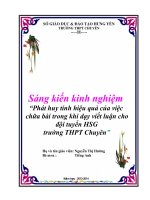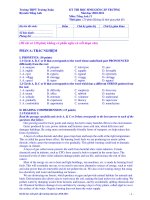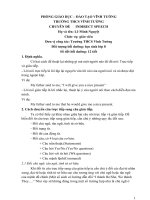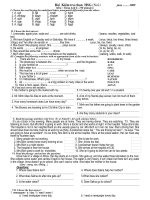CHUYÊN ĐỀ HỌC SINH GIỎI TIẾNG ANH INDIRECT SPEECH
Bạn đang xem bản rút gọn của tài liệu. Xem và tải ngay bản đầy đủ của tài liệu tại đây (157.74 KB, 14 trang )
PHÒNG GIÁO DỤC – ĐÀO TẠO VĨNH TƯỜNG
TRƯỜNG THCS VĨNH TƯỜNG
CHUYÊN ĐỀ INDIRECT SPEECH
Họ và tên: Lê Minh Nguyệt
Chức vụ: giáo viên
Đơn vị công tác: Trường THCS Vĩnh Tường
Đối tượng bồi dưỡng: học sinh lớp 8
Số tiết bồi dưỡng: 12 tiết
1. Định nghĩa.
Có hai cách để thuật lại những gì mà một người nào đó đã nói: Trực tiếp
và gián tiếp.
- Lời nói trực tiếp là lời lặp lại nguyên văn lời nói của người nói và nó được đặt
trong ngoặc kép.
Ví dụ:
My father said to me, “I will give you a nice present’’
- Lời nói gián tiếp là lời nhắc lại, thuật lại ý của người nói theo cách diễn đạt của
mình.
Ví dụ:
My father said to me that he would give me a nice present.
2. Cách chuyển câu trực tiếp sang câu gián tiếp.
Ta có thể thấy sự khác nhau giữa hai câu nói trực tiếp và gián tiếp. Để
biến đổi từ câu trực tiếp sang gián tiếp, cần chú ý những quy tắc đổi sau:
- Đổi chủ ngữ, tân ngữ, tính từ sở hữu.
- Đổi trạng từ.
- Đổi thì của động từ.
- Đổi câu, có 4 loại câu cơ bản:
+ Câu trần thuật.(Statements)
+ Câu hỏi Yes/No.(Yes/No questions)
+ Câu hỏi với từ hỏi (Wh questions)
+ Câu mệnh lệnh(Command)
2.1 Đổi chủ ngữ, tân ngữ, tính từ sở hữu.
Khi đổi từ câu trực tiếp sang câu gián tiếp ta cần chú ý đổi các đại từ nhân
xưng, đại từ hoặc tính từ sở hữu sao cho tương ứng với chủ ngữ hoặc tân ngữ
của mệnh đề chính.(Một số sách có hướng dẫn đổi “I thành He/She, We thành
They….” Như vậy sẽ không đúng trong một số trường hợp như là chủ ngữ ở
1
mệnh đề chính không phải là ngôi thứ 3). Chính vì vậy, ta cần phải chú ý và dựa
vào mệnh đề chính để đổi cho hợp lý.
Trực tiếp Gián tiếp
- Chủ ngữ, tân ngữ, đại từ, tính
từ sở hữu là ngôi thứ nhất
Cùng ngôi với chủ ngữ của
mệnh đề chính
- Chủ ngữ, tân ngữ, đại từ, tính
từ sở hữu là ngôi thứ hai
cùng ngôi với tân ngữ của
mệnh đề chính
- Chủ ngữ, tân ngữ, đại từ, tính
từ sở hữu là ngôi thứ ba
Không đổi
Ví dụ 1:
- My father said to me, “I will give you a nice present’’
My father said to me that he would give me a nice present.
Trong câu trên: chủ ngữ của câu trực tiếp là ngôi thứ nhất, chủ ngữ của
mệnh đề chính là(My father) ngôi thứ 3 nên ta đổi “I” thành “He”(My father).
Tân ngữ của câu trực tiếp là ngôi thứ 2, tân ngữ của mệnh đề chính là ngôi thứ
nhất nên ta đổi “you” thành “me”.
Ví dụ 2:
- Mr John said to his wife that, “I miss you so much”
Mr John said to his wife that he missed her so much.
Ở câu này, nếu ta đổi “you” thành “me/us” thì câu nói này sẽ hoàn toàn
sai so với lời nói của người nói. Vì vậy ta cần chú ý, tân ngữ ở mệnh đề chính là
“his wife” nên ta đổi theo tân ngữ mệnh đề chính phải là “her”.
2.2. Đổi trạng ngữ chỉ thời gian và nơi chốn.
Direct speech Indirect speech
Time
now
ago
Then, at that time, immediately
before
today
tonight
that day
that night
Yesterday the day before . the previous day
2
last week, month, the previous week, month,
Tomorrow the next . following day
next week, month, the following week, month,
Place
Here there
This that
These those
Ví dụ: She said: "I have already seen Carol today."
She said (that) she had already seen Carol that day.
2.3. Đổi thì của động từ.
Khi động từ tường thuật ở thì quá khứ (said, told, ) chúng ta phải lùi một thì về
quá khứ.
Direct speech(TT) Indirect speech(GT)
Present simple Past simple
Present progressive Past progressive
Past simple Past perfect
Past progressive Past perfect progressive
Present perfect Past perfect
Present perfect progressive Past perfect progressive
Past perfect Không đổi
Future and model verbs
will
can
may
must
have to
ought to
used to
would
could
would
could
might
had to
had to
không đổi
3
Direct speech(TT) Indirect speech(GT)
should
had better
…
Ví dụ:
“I have lived here for ten years” Mrs Nga said.
Mrs Nga said that she had live there for ten years.
* Lưu ý: Các trường hợp sau đây không lùi thì:
- Khi động từ tường thuật(mệnh đề chính) ở hiện tại hoặc tương lai thì ta không
thay đổi thì của động từ trong câu gián tiếp.
- Diễn tả chân lý, sự thật.
- Trong câu có thời gian xác định.
- Thì quá khứ hoàn thành.
- Các câu thuộc cấu trúc đã giảm thì rồi ( Sau: as if, as though, if only, wish, it's
high time, would rather, câu điều kiện loại 2, 3 )
Ví dụ:
1. “If I were you, I would help her” he said ?
He said If he were me, he would help her
2. My mother says to me, “you are my little pet.”
My mother tells me that I am her little pet.
3. Tom said to me, “My grandfather died in 1990.”
Tom told me that his grandfather died in 1990.
2.4. Đổi câu.
2.4.1. Câu trần thuật.
Khi đổi câu trực tiếp sang câu gián tiếp ta lần lượt thực hiện các bước sau:
Bước 1: Bỏ ngoặc, thêm “that” vào sau mệnh đề chính.
Bước 2: Đổi chủ ngữ, tân ngữ, trạng từ.
Bước 3: Lùi thì của động từ.
Form.
Ví dụ:
1. Peter said: "Carol is a nice girl."
4
Peter said (that) Carol was a nice girl.
2. Susan said: "My parents are clever scientists."
Susan said (that) her parents were clever scientists
3. They said: "We went swimming with our friends."
They said (that) they had gone swimming with their friend.
Exercise.
1: Change these sentences into Reported Speech: (statements)
1. “We are very happy”. They said.
2. “You sing very nicely, Mary” Nga said .
3. “I like my dog, Spot” John said.
4. “We have plenty of time to do our work“ They said.
5. “I am going to the party with my brother” Hoa said.
6. “I will take you to my house” Mary said
7. “I am a pupil and I have learned English at school” Peter said.
8. “I have to go to the dentist tomorrow.” My brother said.
9. “I am going shopping. Can I get you something?” she said.
10. “I want my room to look nice at the festival,” Hoa said.
Answer key.
1. They said that they were happy
2. Nga said to Mary that she sang very nicely.
3. John said that he liked his dog, Spot.
4. They said that they had plenty of tine to do their homework.
5. Hoa said that she was going to the party with her brother.
6. Mary said to me that she would take me to her house.
7. Peter said that he was a student and that he had learn English at school.
8. My brother said that he had to go to the dentist the next day.
9. She said that she was going shopping and asked me whether she could get me
something.
10. Hoa said that she wanted her room to look nice at the festival.
2.4.2. “Yes/No - question”
Ta lần lượt thực hiện các bước sau:
Bước 1. Đổi động từ trần thuật ở mệnh đề chính thành động từ hỏi.
Bước 2. Bỏ ngoặc, thêm “if” hoặc “Whether” vào sau mệnh đề chính.
5
Bước 3. Đổi câu hỏi thành câu trần thuật.
Bước 4. Đổi chủ ngữ, tân ngữ, trạng từ (nếu có)
Bước 5. Lùi thì của động từ.
Form.
S + asked + O If S + V + O
Whether
Exercise: Change into reported speech ( Questions)
1. “Have you worked before?” she said to him
2. “Can you work on Saturday before?” she said to him
3. “May I open the window?” she asked
4. “Shall I have a day off tomorrow?” she said to her boss
5. “May I borrow your tennis racket?” she asked him
6. “Are you coming to the party tonight, Ha?” she asked
7. “Can you borrow your pen please, Ha?” she asked
8. “Do you know where my tennis racquet is, Mum?” she asked her Mum
9. “Was Ha at work yesterday?” she asked her secretary
10. “Did you read the article about Prince Diana?” she asked him
Answer key.
1. She asked him if he had worked before.
2. She asked him if he could work on Saturday before.
3. She asked me if she might open the window.
4. She asked her boss if she would have a day off the next day.
5. She asked him if she might borrow his tennis racket.
6. She asked Ha if he was coming to the party that night.
7. She asked Ha if he could borrow his pen .
8. She asked her mum if she knew where her tennis racket was.
9. She asked her secretary if Ha had been at work the day before.
10. She asked him if he had read the articke about Prince Diana.
2.4.3. “Wh - questions”
Ta lần lượt thực hiện các bước sau:
Bước 1. Đổi động từ trần thuật ở mệnh đề chính thành động từ hỏi.
Bước 2. Bỏ ngoặc, giữ nguyên từ hỏi vào sau mệnh đề chính.
Bước 3. Đổi câu hỏi thành câu trần thuật.
6
Bước 4. Đổi chủ ngữ, tân ngữ, trạng từ (nếu có)
Bước 5. Lùi thì của động từ.
Form.
S + asked + O Wh + S + V + O
Ví dụ:
1. “Where did you go last night, Ba?”, The father said.
The father asked Ba where he had gone the night before.
The father wanted to know where Ba had gone the night before.
Note: Đối với câu hỏi ta có thể sử dụng các động từ hỏi hoặc dung cụm động từ
“wanted to know”.
Exercise
1. What time do you want to leave for the airport ?” Harry asked me .
2. “ Where will you come to see you this weekend ?” She asked me .
3. “ Where does your father work ?” the teacher asked me .
4. “ Why do you collect waste paper ?” She asked Ba .
5. “ How much does this dress cost ?” Lan asked Lien .
6. “ What kind of books do you read ?” Thu asked Huong .
7. “Where does your son want to learn ?” the man told me
8. “What do you usually do in your free time ?” the examiner asked
2.4.4. Câu mệnh lệnh.
Câu mệnh lệnh: Là loại câu yêu cầu người khác làm gì đó, cách nhận dạng câu
* Câu mệnh lệnh khẳng định.
Bước 1. Đổi động từ trần thuật thành động từ yêu cầu, đề nghị.
Bước 2. Bỏ ngoặc, thêm “to” vào trước động từ chỉ hành động.
Ví dụ:
1. “Do your homework before going to school.” Teacher said.
Teacher asked students to do homework before going to school.
2. The teacher said: "Keep silent and look at the blackboard!"
The teacher told us to keep silent and look at the blackboard.
told
S + asked + sbd + to V
ordered
7
* Câu mệnh lệnh phủ định.
Bước 1. Đổi động từ trần thuật thành động từ yêu cầu, đề nghị.
Bước 2. Bỏ ngoặc, thêm “not to” vào trước động từ chỉ hành động.
Ví dụ:
1. John said: "Don't forget to call me when you get home, Anna!"
John told Anna not to forget to call him when she got home
told
S + asked + sbd + not to V
ordered
* Một số lưu ý khi đổi câu mệnh lệnh từ trực tiếp sang gián tiếp.
- Động từ tường thuật động từ chỉ yêu cầu, mệnh lệnh.
Said told/ ordered/ asked……
- Người được nói đến phải được đặt ngay sau động từ chỉ mệnh lệnh.
S + V + sbd + to V/not to V
- Trong lời nói trực tiếp không có người thực hiện hành động nhưng trong
lời nói gián tiếp thì phải có.(Nếu không thì phải thêm vào một đại từ hoặc
một danh từ)
Ví dụ:
He said, “Go away”
He told me to go away
Exercise.
Change these derect speeches into indirect speech.
1. Their mother said to them, “Don’t make so much noise.”
2. The traffic policeman said, “Show me your driving license, please.”
3. Mrs. Jackson said to Tim, “Could you give me a hand, please?”
4. The lifeguard said, “Don’t swim out too far, boys.”
5. Nam said to the taxi driver, “Please turn left at the first traffic light.”
6. She said to her son, “Go straight upstairs and get into bed.”
7. The policeman said, “Don’t touch anything in the room.”
8. Mary said to John, “Can you carry my suitcase, please?”
8
Answer:
1. Their mother asked/ told them not to make so much noise.
2. The traffic policeman asked/ told me to show him my driving license.
3. Mrs. Jackson asked/ told Tim to give her a hand.
4. The lifeguard asked/ told the boys not to swim out too far.
5. Nam asked/ told the taxi driver to turn left at the first traffic light.
6. She asked/ told her son to go straight upstairs and get into bed.
7. The policeman asked/ told people not to touch anything in the room.
8. Mary asked/ told John to carry her suitcase.
3. Các dạng đặc biệt trong câu gián tiếp
Khi đổi câu trực tiếp sang câu gián tiếp có một số loại câu không đổi như
các dạng cơ bản trên mà ở mỗi dạng câu có cách đổi khác nhau.
3.1. Câu gián tiếp với lời khuyên:
Ví dụ:
1. The teacher said, “You should study harder, Mai”
The teacher advised Mai to study harder.
2. Mrs Vui said, “ You’d better get up early and do morning exercise.”
Mrs Vui advised me to get up early and do morning exercise.
3. “ Why don’t you go to school early? ”, said my mother.
My mother advised me to go to school early.
4. My friend said to me, “ If I were you, I would met him”
My friend advised me to meet him.
Form:
Direct speech Indirect speech
S + had better
S + should
Why don’t you….
If I were you…
S + advised + sbd + to V/not to V + O
3.2. Câu gián tiếp với câu gợi ý (suggestion)
Đối với các mẫu đưa ra lời gợi ý thì dùng công thức:
Ví dụ:
9
- My friend said to me, “Let’s go out for a drink”
My friend suggested going out for a drink.
- My friend said ,” Why don’t we go out for a drink ? ”
My friend suggested going out for a drink.
Direct speech Indirect speech
Let’s…
Why don’t we…
Shall we…
How about …
(not)Ving + O
S + suggested + (that) + S + should + V + O.
(that) + S + shouldn’t + V + O.
3.3. Câu gián tiếp với lời mời.
Ví dụ:
- “Would you like to come to my party “
He invited me to come to his party.
Direct speech Indirect speech
Would you like ….? S + invited + sbd + to V
3.4. Câu gián tiếp với câu cảm thán.
* Khi câu trực tiếp là câu cảm than với How/ What ta chuyển sang gián tiếp
bằng cách dùng động từ tường thuật exclaim ( kêu lên , thốt lên)
Ví dụ:
- “What a lovely dress !”
She exclaimed with delight that the dress was lovely.
- “Oh! I’ve cut myself” said the little boy.
The little boy exclaimed with pain that he had cut himself.
Các danh từ thường dùng trong mẫu này là:
Delight ( thích thú, vui sướng)
Admiration ( ngưởng mộ )
Horror ( sợ hải)
Satisfaction (hài lòng)
Surprise ( ngạc nhiên)
10
Pain (đau đớn)
Regret (tiếc nuối)
Disappointment ( thất vọng)
…….
3.5. Các dạng câu kép (có 2 câu nói trong 1 dấu ngoặc kép) :
Thông thường các câu đề cho thường chỉ có 1 câu, nhưng đôi khi các em cũng
gặp các câu đề cho 2 câu. Đối với các trường hợp này ta phải dùng liên từ để nối
chúng lại; các liên từ thường dùng là :
* Nếu 2 câu là nguyên nhân, kết quả của nhau thì theo nghĩa mà dùng:
Because/ So
Ví dụ:
- “Don’t tell me to do that. I don’t like it “
=> He asked me not to tell him to do that because he did not like it.
* Nếu 2 câu đó không có liên quan về nhân quả mà chỉ là 2 câu nói liên tiếp
nhau thì dùng:
And added that ( và nói thêm rằng)
Ví dụ:
“ I miss my mother. I will visit her tomorrow.”
=> She said that she missed her mother and added that she would visit her the
next day.
* Nếu 2 câu khác dạng nhau thì tùy câu đầu vẫn làm bình thường sau đó thêm
and và động từ tường thuật riêng của câu sau.
Ví dụ:
- “This is my book. Don’t take it away.” ( câu đầu dạng phát biểu, câu sau dạng
mệnh lệnh)
She said that was her book and told me not to take it away.
- “Tomorrow is my birthday. Do you remember that?” ( câu đầu dạng phát
biểu, câu sau dạng câu hỏi)
=> She said that the next day was her birthday and asked me if I remembered
that.
3.6. Một số dạng khác.
Đối với các dạng câu ở trực tiếp là những câu có tính chất chúc mừng, xin
lỗi , van xin…. thì khi chuyển sang câu gián tiếp ta có các cấu trúc câu riêng lẻ
cần nhớ sau:
1. S + admitte + Ving Thú nhận, thừa nhận làm việc gì.
11
2. S + apologise + to sbd + for + N/Ving Xin lỗi ai về việc gì
3. S + beg + sbd + to V Van xin, nài nỉ ai làm gì
4. S + blame + sbd + for + N/Ving. Khiển trách ai về việc gì
5. S + congratulate + sbd + on + N/Ving Chúc mừng ai về việc gì
6. S + insist + on + Ving Khăng khăng đòi làm gì
7. S + promise + to V + sth Hứa sẽ làm gì
8. S + refuse + to V + sth Từ chối làm gì
9. S + thank + sbd + for + N/Ving Cảm ơn ai về việc gì
10. S + threaten + to V + sth Dọa, báo trước sẽ làm gì
11. S + warn + sbd + about/of + N/Ving Cảnh cáo ai về việc gì
12. S + wish + to V Hứa làm gì
Ví dụ:
1. “I’m afraid I’ve lost the photo you gave me last week.” The boy said.
The boy admitted losing the photo I had given him the previous week.
2. He said to his boss, “I’m sorry for being late twice”
He apologised to his boss for being late twice.
3. “Please don’t tell my parents about this” she said to me.
She begged me not to tell her parent about that.
4. “It was your fault. You didn’t tell the truth” she said.
She blamed me for not telling the truth.
5. “Congratulations! You’ve passed the exam” He said
He congratulated me on having passed the exam.
6. John said, “I really must have a break”
John insisted on having a break.
7. “I will come on time” she said.
She promised to come on time.
8. “I’m afraid I can’t go to the cinema with you tonight” she said.
She refused to go to the cinema with me that night.
9. I said to the poster, “thanks for carrying my luggage.”
I thanked the poster for carrying my luggage.
10. “If you do that again, I’ll leave” the worker said angrily.
The worker threatered to leave if I did that again.
12
11. “Happy new year!”
She wished me a happy new year.
4. Practice.
Exercise 1.
Yesterday morning Mr. Robinson was ill. He went to the doctor and the doctor
gave him some advice. Report the doctor’s advice.
Ex: “You should take a few days off.”
The doctor said he should take a few days off.
1. “You should stay in bed for a few days.”
2. “You should take these medicines every four hours.”
3. “You ought to keep your body warm.”
4. “You shouldn’t drink alcohol or smoke.”
5. “You ought not to eat fatty food.”
6. “You should take a little hot milk before sleeping.”
Answer:
1. The doctor said he should stay in bed for a few days.
2. The doctor said he should take those medicines every four hours.
3. The doctor said he ought to keep his body warm.
4. The doctor said he shouldn’t drink alcohol or smoke.
5. The doctor said he ought not to eat fatty food.
6. The doctor said he should take a little hot milk before sleeping.
Exercise 2: Turn these sentences into reported speech:
1. “You took the money”, he said.(accuse)
2. “I stole his bicycle”, he said to the police.(admit)
3. He said to the police, “I didn’t steal the bike”.(deny)
4. He said, “I’m sorry I’m late”. (apologize)
5. “I’ll drive you to the airport. I insist.”, John said to Linda.(insist)
6. “I’m happy to hear that you have passed the final exam. Congratulations!”,
Jim said to me. (congratulate)
7. “It was nice of you to invite me to dinner. Thank you.”, Miss White said to
George. (thank)
8. Don’t play with the matches.”, I said to Jack. (warn… against)
9. “I’m sorry I didn’t phone you earlier.”, Margaret said to him.(apologize)
10. The student said , “I didn’t cheat in the exam.” (deny)
Answer.
1. He accuse me to take the money.
2. He admitted stealing his bicycle.
3. He denied stealing the bike.
4. He apologized being late.
13
5. John insisted on driving Linda to the airport.
6. Jim congratulate me on having passed the final exam.
7. Miss White thanked George for inviting him to dinner.
8. I warned Jack not to play with the matches.\
9. Margaret apologized not phoning him earlier.
10. The student dinied cheating in the exam.
14









